|
Fraction to Decimal
|
|||||||||||||||||||||||||||||||||||||||||||||||||||||||||||||||||||||||||||||||||||||||||||||
| Here's what you can find on this page: |
Well, fraction to decimal conversion is actually classic division (we could say, for later grades). It’s doing division all the way.
So let’s say something more about division itself, because this story is all about division.
You should know that we have:
3 Types of Division
- Division without remainder: quotient is a whole number
|
|
= |
|
|
| 6 | = 6÷2 | = | 3 |
| 2 | |||
Q = 3
This is classic no remainder, clean and "most wanted" division. ;-)
- Division with remainder: quotient is a whole number, plus we have another "indivisible" whole number as a remainder on the side.
|
|
= |
|
+ | ||||
| 7 | = 7÷2 | = | 3 | + | 1 | ||
| 2 | 2 | ||||||
Q = 3 R = 1
We can't divide number 1 by 2 and get a whole number as a result, so we leave it indivisible as 1/2. Number 1 is in this case our remainder. This type of division is actually an intro to:
- "Full" division (divides even the remainder part): quotient is a decimal number.
This means, it consists of a whole number part, and a decimal (fraction) part.
|
|
= |
|
. | ||
| 7 | = 7÷2 | = | 3 | . | 5 |
| 2 | |||||
Q = 3.5
Why the ".5" part instead of the 1/2? Because we must present our decimal part within a based-on-10s fraction system. So, we expanded 1/2 to get 10ths:
 |
= |
 |
||||
| 1 | = | 5 | ||||
| 2 | 10 | |||||
So, in this case we’ve managed to represent our remainder in 10ths, but if we couldn’t, we would’ve gone further and tried representing it in 100ths, 1000ths, 10,000ths etc, by dividing further.
In our case of fraction to decimal conversion we’re dealing with this final type – getting decimal numbers out of fractions.
There are some:
Special cases of
Fraction to Decimal Conversion
that can be solved really quickly, and the rest is just plain old division till you die. ;-)
Let’s start with easy classic examples, and then build our way up.
The simplest conversions from fraction to decimal is when we have 10ths, 100ths, 1000ths etc, as a denominator. So let’s give those examples first.
|
The following principle applies: |
In the following example we have only one zero in the denominator, that means that we’re going to have only one decimal place at the end of our conversion.

There is another angle that you can look at this. If we imagine there is an “invisible” decimal point right next to the numerator number (like 4. and 23. and 528.), we can see that it has “emerged” after dividing by 10 and moved to the left for 1 decimal space.
|
Digression: When we divide by 10s decimal point goes to the left, and when we multiply by 10s – it goes to the right. |
We have the same analogy in our next example. Now we have two zeros in the denominator, which means that we’re going to have two decimal places "after" the decimal point.

Or looking at it from the above mentioned second angle, our "invisible" decimal point has "resurfaced" and, because of two zeros in the denominator, has moved two decimal places to the left.
Finally let’s see "three-zeros" example, just to make sure we’re on the same track here. So now we have 3 zeros in the denominator – hence the 3 decimal places in the decimal number.
As you can see if we don’t have "enough" numbers to put in, and we must honor the "same-number-of zeros-and-decimal-places" rule => we input zeros. :-)

And the second approach: our former invisible decimal points, due to 3 zeros in the denominator, have "reappeared" and "traveled" 3 decimal places to the left.
These were the easiest examples. Let’s see some slightly harder examples. Those would be where we can expand or simplify our fractions to get 10ths, 100ths, 1000ths etc for our denominator, because afterwards the previous rule applies.
Whenever the opportunity arises, we should avoid division. That’s usually doable when we have the following numbers as denominators:
|
So in order to get 10ths, 100ths, 1000ths etc, we can:
- expand
- simplify, or
- combine the above two
Look at the following example.
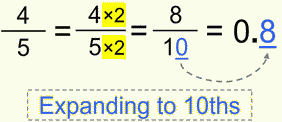
As you remember, expanding is multiplying both a numerator and a denominator by a same number. And since our goal is to get 10ths, we multiplied 5ths by 2, and afterwards it’s easy-peasy.
Of course, same applies for the halves:
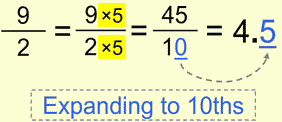
Well, as we mentioned earlier, there may be cases when is much more convenient to simplify to get 10ths, rather than to expand.
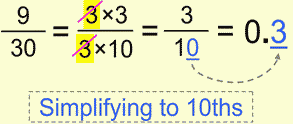
This works of course because we conveniently had the common factors up and down.
Now if you’re really determined to avoid plain old division – you can try combining those two.

As you can see, we combined simplifying and expanding in order to get 10ths. Sometimes this won’t be so obvious but it’s worth trying if it doesn’t take much of your time.
Here’s another combination.

I guess you’re wondering: "When the heck are we going to see the real fraction to decimal conversion here?!" Easy tiger, we’re getting there. :-P
This is a necessary process, trust me. Sometimes slower is faster (or something like that). Understanding is knowing.
Now let me show you some 100ths tricks.
This is expanding to 100ths:
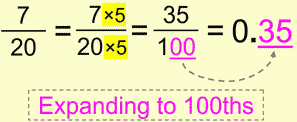
And of course we’re expanding because we can’t simplify to 10ths, because 7/2 won’t give us a whole number. So we’re multiplying by 5, and applying the same principle as before (number of zeros in the denominator = number of decimal places after the decimal point).
Here’s an example of simplifying to 100ths:
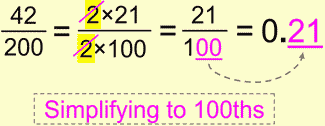
I guess this was really obvious, but it’s here to illustrate a point that you can use it and save yourself from division if you can recognize it.
Let’s wrap this simplifying/expanding stuff with its combo.

This one was maybe a stretch, but it still depicts what can be done if you practice a little. Believe me, math is all about recognizing patterns, and for that you need practice.
Finally I think it’s time to do some:
Regular
Fraction to Decimal Conversion
No special cases, no bending your gray cells, just plain old division.
|
But before we move on, you should know this:
This, of course applies for every number. You get the picture... |
Again, to illustrate a point, let’s start with easy examples.
Fraction to decimal conversion, one-decimal-place case.
|
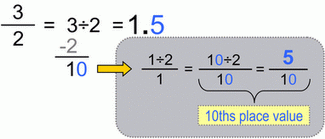
|
Fraction to decimal conversion, 2-decimal-places case.
|
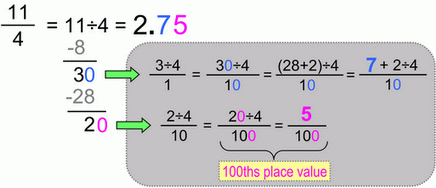
|
Fraction to decimal conversion, 3-decimal-places case:
|
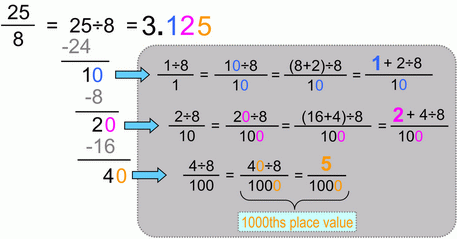
|
Much has been said on this page, and I guess most of the fraction to decimal conversion ground is covered. If you are really, and I mean really crazy about this topic – drop me a line and I’ll elaborate more. :-)
|
Go from Fraction to Decimal Conversion to Math Help With Fractions Go from Fraction to Decimal Conversion to Free Math Help Online - Home Page |





